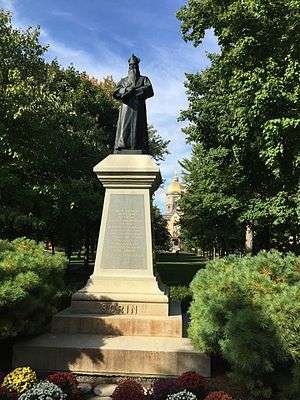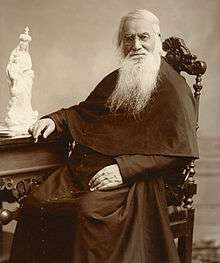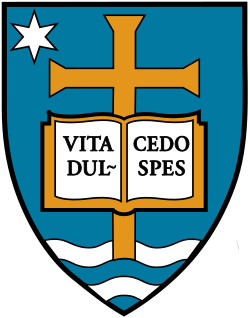Edward Sorin
Rev. Edward Frederick Sorin (French: Édouard Sorin[1]), C.S.C. (February 6, 1814 – October 31, 1893) was a priest of the Congregation of Holy Cross and the founder of the University of Notre Dame in Indiana and of St. Edward's University in Austin, Texas.
Edward Sorin | |
|---|---|
 | |
| 1st President of the University of Notre Dame | |
| In office 1844–1865 | |
| Preceded by | Inaugural holder |
| Succeeded by | Patrick Dillon |
| 1st American Provincial Superior of the Congregation of Holy Cross | |
| In office 1865–1868 | |
| 3rd Superior General of the Congregation of Holy Cross | |
| In office 1868–1893 | |
| Preceded by | Pierre Dufal |
| Succeeded by | Gilbert Français, C.S.C |
| Personal details | |
| Born | Édouard Sorin February 6, 1814 Ahuillé, France |
| Died | October 31, 1893 (aged 79) South Bend, Indiana, U.S. |
| Resting place | Holy Cross Cemetery, Notre Dame, Indiana |
| Profession | Priest |
Youth
Edouard Frédéric Sorin was born on February 6, 1814, at Ahuillé, near Laval, France. His early education was by his mother. Later, after completing his classical studies, Sorin entered the diocesan seminary, recognized for his ability and notable life. Among his fellow students was the future Cardinal Langénieux.[2] He completed his time at seminary and was ordained as a priest in 1838.[3]
Missionary to America
At the time of Sorin's ordination, reports of missionary enterprise in foreign lands, including those in China and Japan, motivated French clergy and inspired numerous vocations. Abbé Sorin was influenced by circumstances to enroll himself in the Congregation of Holy Cross, a community of priests, brothers, and sisters lately founded at Le Mans by the Blessed Basil Moreau. The need of missionaries in the United States, represented by bishops in this country, was not to be disregarded by the heads of religious orders. In addition, while France had not recovered from the effects of the Revolution, it contributed many men and the means to support American Missions.[2] Sorin, recently ordained, was selected by his superiors to establish the Congregation of Holy Cross, organized at Le Mans, in what was then considered a remote district of the United States.[4]
Founding of the University of Notre Dame

Accompanied by six brothers of the congregation, he arrived in New York in the autumn of 1841, and immediately set out for Indiana, the center of his apostolate for upwards of half a century. After a short stay at St. Peter's in the Diocese of Vincennes, he proceeded northward with five of his group.[2] They were invited by Bishop Célestine Hailandière.[3] At the age of 28 on November 26, 1842, Sorin began the foundation of Notre Dame during an exceptionally rigorous winter. Father Sorin and his Holy Cross brothers took possession of 524 snow-covered acres that the Bishop of Vincennes had given them in the Indiana mission fields. He named his fledgling school in honor of Our Lady, in his native tongue of French, “L’Université de Notre Dame du Lac” (The University of Our Lady of the Lake). The first residents to receive an education at Notre Dame were orphans from a home established by the Brothers of Saint Joseph to educate children beyond the ages of twelve and thirteen.[5]
Sorin, following Moreau's example, sent out priests and brothers to found other schools and parishes throughout the United States and Canada. On Jan. 15, 1844, the Indiana legislature officially chartered the University of Notre Dame.[6]
Sorin, from the French seminary system, was by temperament more of an administrator than an academician or intellectual.[7] He ran Notre Dame on the model of a French boarding school, which included elementary (the "minims"), preparatory, and collegiate programs, as well as a manual training school. Over the years, he accepted the recommendations of others, including Fr. John A. Zahm, C.S.C., to strengthen Notre Dame's academic curriculum.[8]

Sorin's strength was best demonstrated on April 23, 1879 when a fire destroyed the Main Building, which housed virtually the entire university.[10] Following the pledge made by the university's president, William Corby, C.S.C., Notre Dame would reopen for the fall term.[11] Sorin also willed Notre Dame to rebuild and continue its growth. As recounted in Notre Dame: 100 Years (1942):
"The sixty-five year old man walked around the ruins, and those who followed him were confounded by his attitude. Instead of bending, he stiffened. There was on his face a look of grim determination. He signaled all of them to go into the church with him." [12]
Timothy Edward Howard provided a first-person account of what Sorin said inside Sacred Heart Church:
"I was then present when Father Sorin, after looking over the destruction of his life-work, stood at the altar steps of the only building left and spoke to the community what I have always felt to be the most sublime words I ever listened to. There was absolute faith, confidence, resolution in his very look and pose. 'If it were ALL gone, I should not give up!' were his words in closing. The effect was electric. It was the crowning moment of his life. A sad company had gone into the church that day. They were all simple Christian heroes as they came out. There was never more a shadow of a doubt as to the future of Notre Dame."[12]
An alternative version of Sorin's post-fire address has increased in popularity. It argues that Our Lady (the Virgin Mary) burned down the Main Building because he built it too small, and that he would now rebuild it "bigger and better than ever".[13] This version seems apocryphal as it was not included in any contemporaneous accounts of the event or in Sorin's own writings. Sorin believed a divine hand was involved in the fire's origins, but ascribed it directly to God, whom Sorin suspected of being angry over "infidelity" and "neglect," not the dimensions of the building.[14]
Sorin had an ambitious goal for the new Administration Building, constructed over the summer of 1879. He wanted it to be nothing less than a "monument to Catholicism."[15] Having stood for some 135 years, the Administration Building with its Golden Dome served as a monument. Catholicism generally and millions of working-class first- and second-generation American Catholics were inspired to see their sons (and eventually daughters) pursue higher education. It allowed them to gain entry into the mainstream of American social, economic, and political life.

Far from Indiana to India, the flourishing mission in Eastern Bengal, headed by the Congregation of Holy Cross, owes much of its success to Father Sorin's active co-operation and zeal. He sent its former bishop and other priests together with a band of sisters, described as a worthy group. The founding of the Congregation of the Sisters of the Holy Cross in the United States is regarded as one of Sorin's most important services to religion. Under his administration and care, this community grew from small to possessing flourishing establishments in a dozen states. During the American Civil War, under Sorin's forethought, this sisterhood was able to furnish nearly eighty nurses for sick and wounded soldiers on transports and in hospitals. A number of priests of the Congregation of Holy Cross, among them Fr. William Corby, C.S.C., served as chaplains at the front. Sorin's also established the Ave Maria Press in 1865.[4]
Later years
Sorin was elected superior-general of his order in 1868, and held this office for the rest of his life. During his tenure as Superior General, Fr. Sorin made around 50 voyages across the Atlantic to deal with the affairs of the Congregation in France and Rome. He was invited to attend the Plenary Council of American Bishops at Baltimore in 1884. Cardinal Gibbons, two other archbishops, and 12 bishops attended his golden jubilee celebration in 1888. In recognition of his work in education, the French Government conferred upon him the insignia of Officer of Public Instruction (1888). Soon after the celebration of his sacerdotal golden jubilee (the same year), Sorin entered into a long period of mental and physical suffering.[4] He died a peaceful and painless death of Bright's Disease at the University of Notre Dame on the eve of All Saints' Day, October 31, 1893.
Founding of St. Edward's University
Sorin also founded St. Edward's University in Austin, Texas. Bishop Claude Marie Dubuis of the Diocese of Galveston learned of Mrs. Mary Doyle's intention to leave her large South Austin farm to the Catholic Church. The purpose was to establish an "education institution" and he invited Father Sorin to Texas in 1872. Answering the bishop's invitation, Father Sorin traveled to Austin and surveyed the beauty of the surrounding hills and lakes. A year later, following Mrs. Doyle's death, he founded a Catholic school called St. Edward's Academy in honor of his patron saint, Edward the Confessor and King. In the fledgling institution's first year, 1878, three farm boys made up the student body and met for classes in a makeshift building on the old Doyle homestead. In 1885, the academy secured its charter as a college. Sorin Hall and nearby Sorin Oak — the largest oak tree in Austin — are also named after him.
References
- "Édouard Sorin", in Alphonse-Victor Angot et Ferdinand Gaugain, Dictionnaire historique, topographique et biographique de la Mayenne, Laval, Goupil, 1900-1910, t. III, p. 719.
- "Archives of the University of Notre Dame: Sketch of Father Edward Sorin's Life". Archives.nd.edu. Retrieved 2014-07-10.
- "Edward Frederick Sorin | American educator". Encyclopedia Britannica. Retrieved 2018-10-17.
- Hudson, Daniel."Edward Sorin." The Catholic Encyclopedia Vol. 14. New York: Robert Appleton Company, 1912. 20 February 2020PD-notice}}
- "Rev. Edward Sorin, C.S.C.", De Nicola Center for Ethics and culture
- "University of Notre Dame". Holycrossusa.org. 2014-03-24. Archived from the original on 2017-07-02. Retrieved 2014-07-10.
- Marvin O'Connell, Edward Sorin, pp. 564, 626
- M. O'Connell, supra, pp. 564, 627.
- http://articles.chicagotribune.com/2004-09-26/travel/0409250216_1_edward-sorin-campus-golden-dome
- "The Great Fire of 1879 | Notre Dame Archives News & Notes". Archives.nd.edu. 2014-04-23. Retrieved 2014-07-10.
- M. O'Connell, supra, p. 651
- Hope, C.S.C., Arthur C."Notre Dame -- One Hundred Years"|date=May 7, 2012
- "I came here as a young man and dreamed of building a great university in honor of Our Lady. But I built it too small, and she had to burn it to the ground to make the point. So tomorrow as soon as the bricks cool, we will rebuild it, bigger and better than ever."
- "Who can take it [the fire], at first sight, for anything else but a punishment? ... We all hope it will prove a salutary punishment of something that has displeased God but a punishment is meant; to see anything else in our catastrophe could hardly be sustained by any process of reasoning." url=http://www.archives.nd.edu/circulars/CLO1-1879-05-01.pdf |format=PDF |title=Circular Letter No. 96 |date=May 1, 1879 |publisher=Archives.nd.edu.
- "By all means we must bring upon these new foundations the richest blessings of Heaven, that the grand edifice we contemplate erecting may remain for ages to come a monument to Catholicism, and a stronghold which no destructive element can ever shake on its basis or bring down again from its majestic stand. Circular Letter No. 96, supra.
![]()
Other sources
- Marvin R. O'Connell, Edward Sorin. Notre Dame: University of Notre Dame Press, 2001. ISBN 0-268-02759-5
- Sorin, Edward. "Chronicles of Notre Dame du Lac." John M. Toohey, translator, 1895. Online at University of Notre Dame Archives
| Wikimedia Commons has media related to Edward Sorin. |
